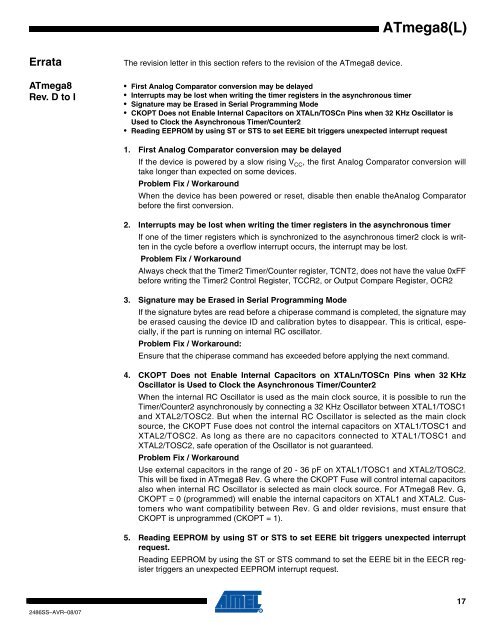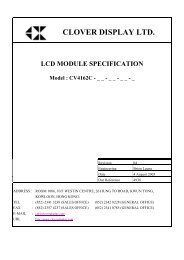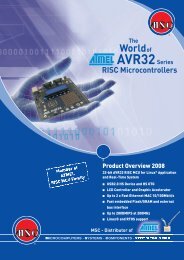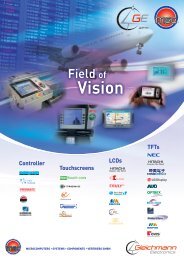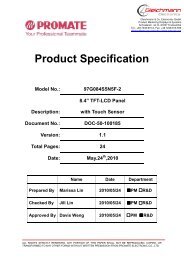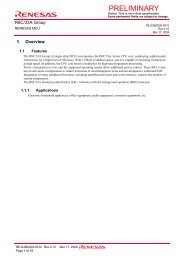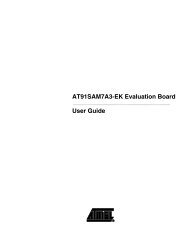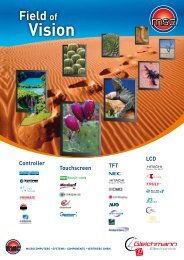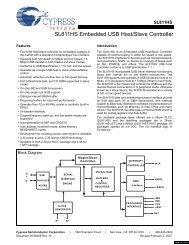ATmega8(L)
ATmega8(L)
ATmega8(L)
You also want an ePaper? Increase the reach of your titles
YUMPU automatically turns print PDFs into web optimized ePapers that Google loves.
<strong>ATmega8</strong>(L)Errata<strong>ATmega8</strong>Rev. D to IThe revision letter in this section refers to the revision of the <strong>ATmega8</strong> device.• First Analog Comparator conversion may be delayed• Interrupts may be lost when writing the timer registers in the asynchronous timer• Signature may be Erased in Serial Programming Mode• CKOPT Does not Enable Internal Capacitors on XTALn/TOSCn Pins when 32 KHz Oscillator isUsed to Clock the Asynchronous Timer/Counter2• Reading EEPROM by using ST or STS to set EERE bit triggers unexpected interrupt request1. First Analog Comparator conversion may be delayedIf the device is powered by a slow rising V CC , the first Analog Comparator conversion willtake longer than expected on some devices.Problem Fix / WorkaroundWhen the device has been powered or reset, disable then enable theAnalog Comparatorbefore the first conversion.2. Interrupts may be lost when writing the timer registers in the asynchronous timerIf one of the timer registers which is synchronized to the asynchronous timer2 clock is writtenin the cycle before a overflow interrupt occurs, the interrupt may be lost.Problem Fix / WorkaroundAlways check that the Timer2 Timer/Counter register, TCNT2, does not have the value 0xFFbefore writing the Timer2 Control Register, TCCR2, or Output Compare Register, OCR23. Signature may be Erased in Serial Programming ModeIf the signature bytes are read before a chiperase command is completed, the signature maybe erased causing the device ID and calibration bytes to disappear. This is critical, especially,if the part is running on internal RC oscillator.Problem Fix / Workaround:Ensure that the chiperase command has exceeded before applying the next command.4. CKOPT Does not Enable Internal Capacitors on XTALn/TOSCn Pins when 32 KHzOscillator is Used to Clock the Asynchronous Timer/Counter2When the internal RC Oscillator is used as the main clock source, it is possible to run theTimer/Counter2 asynchronously by connecting a 32 KHz Oscillator between XTAL1/TOSC1and XTAL2/TOSC2. But when the internal RC Oscillator is selected as the main clocksource, the CKOPT Fuse does not control the internal capacitors on XTAL1/TOSC1 andXTAL2/TOSC2. As long as there are no capacitors connected to XTAL1/TOSC1 andXTAL2/TOSC2, safe operation of the Oscillator is not guaranteed.Problem Fix / WorkaroundUse external capacitors in the range of 20 - 36 pF on XTAL1/TOSC1 and XTAL2/TOSC2.This will be fixed in <strong>ATmega8</strong> Rev. G where the CKOPT Fuse will control internal capacitorsalso when internal RC Oscillator is selected as main clock source. For <strong>ATmega8</strong> Rev. G,CKOPT = 0 (programmed) will enable the internal capacitors on XTAL1 and XTAL2. Customerswho want compatibility between Rev. G and older revisions, must ensure thatCKOPT is unprogrammed (CKOPT = 1).5. Reading EEPROM by using ST or STS to set EERE bit triggers unexpected interruptrequest.Reading EEPROM by using the ST or STS command to set the EERE bit in the EECR registertriggers an unexpected EEPROM interrupt request.2486SS–AVR–08/0717


